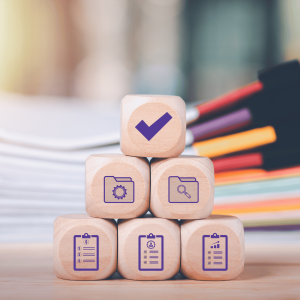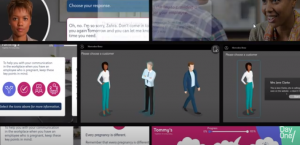In the world of eLearning, assessments play a pivotal role in gauging learner progress and knowledge retention. Often misunderstood as a mere test at the end of a learning module, assessments hold much more significance. They serve as powerful tools that drive engagement, reinforce learning, and provide valuable insights for instructional design improvement.
Cathy Moore is a huge advocate for a learning by doing approach in elearning and this is demonstrated in her Action Mapping process find out more about her Action Mapping Process here.
Cathy Moore’s Action Mapping is a visual approach to instructional design. It helps to demonstrate why activity rich, relevant materials are key in learning. It focuses on what people need to do and links it back to business objectives by developing learning that will help people practice making decisions that they make on the job – making it a learning experience that challenges learners using assessments and scenarios.

The assessments need to be completely tied into what is being taught to ensure the learners have grasped what has been covered and can apply it effectively. By assessing knowledge and skills directly related to the content in the right format, you are gaining a more reliable measure of a learner’s understanding and progress.
Tying in the content also promotes accountability and reinforces the importance of active engagement with the content, encouraging the learners to take ownership of their learning.
In this blog post, we will delve into the importance of assessments in eLearning and explore the factors that drive how and why we implement them, including examples of what we have done here at Day One to make sure assessments are integrated throughout and to further demonstrate that leading with scenario driven assessments can provide learners with more engaging content.
1. Measuring Learning Outcomes
Assessments go beyond being a simple evaluation tool; they serve as a means to measure learning outcomes. By strategically incorporating assessments/scenarios throughout the eLearning journey, we can gauge learners’ understanding, identify knowledge gaps, and assess their ability to apply concepts in real-world scenarios.
Providing questions between content makes it less of a memory test and a much more accessible route to take. Asking questions or providing a scenario immediately after talking about that particular topic is more realistic. It also allows for the learner to learn at their own pace and making it much easier to comprehend what they are being asked to do.
For BOC we created a gamified element to the assessment, throughout each section of the eLearning, learners were asked to complete various tasks related to their role or answer questions based on the content they had just viewed or even at the start of a section to test their initial understanding, they were awarded flags for each section they got correct. It then showed them at the end which ones they had missed and allowed them to recap those sections using job aids that they would have access to in the real world – reminding them that they have access to the information whenever they need it. This helped the learners to understand the sections they needed to spend more time on and where there were knowledge gaps.

2. Encouraging Active Learning
Assessments encourage active participation and engagement in the learning process. When learners know that they will be assessed, they are motivated to pay closer attention, take notes, and critically analyse the content.
By integrating different types of assessments, such as scenarios, quizzes, case studies, simulations, and group activities, eLearning becomes interactive, stimulating learners’ critical thinking skills and promoting knowledge retention.
The work we did with Worldwide Flight Services (WFS) led us to create operational risk training simulations that were as true-to-life as possible in an eLearning environment.
Our team developed an eLearning course comprising of realistic airport and warehousing logistics scenarios, and a realistic simulation of their software system so that they could practise in a safe environment. Immediately providing realistic scenarios one after the other to the learners and then providing a concise recap, gives the learner a sense of activity based learning (or learning by doing) instead of learning dry theory and the risk assessment process, followed by one lonely knowledge check at the end. WFS operatives can now ‘risk assess’ 3D airport scenes and enter their findings on a true-to-life version of their software.
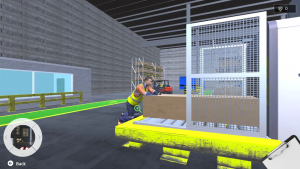
3. Reinforcing Learning and Retrieval Practice
One of the key benefits of assessments is their ability to reinforce learning and facilitate retrieval practice. Regular assessments prompt learners to recall and apply information, strengthening their memory and improving long-term retention.
When learners are actively retrieving knowledge, they reinforce neural connections and enhance their ability to recall information in real-life situations, ultimately boosting the effectiveness of the learning experience.
We created an extensive series of modules for the Ministry of Defence that included lots of information. So using assessment techniques for the learner to retrieve information from a virtual environment to answer questions and locate further information if they needed it, was key.
It allowed them to practise their skills and reinforce their decision making skills when needed.
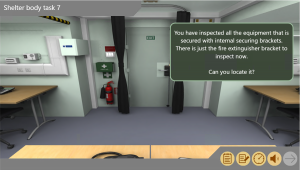
4. Providing Timely Feedback
Well-designed assessments offer learners timely feedback, providing them with valuable insights into their performance and areas for improvement. Feedback not only informs learners of their progress but also guides them towards a deeper understanding of the subject matter. Constructive feedback enables learners to self-reflect, identify misconceptions, and make necessary adjustments, fostering a continuous learning process. It’s important to let the learner think, so the feedback needs to show the result of their choices rather than just telling them they are correct or incorrect – or in Cathy Moore’s words – Eager Beaver Feedback – find out what it is here
If you describe what has happened based on their choice they are more likely to find the learning more memorable – in turn making it more realistic and more likely the learner will remember what they have learned.
When we worked with Mercedes on how they can personalise customer experiences when communicating at a distance, such as via email or phone, we created an interactive practice environment including gamification elements, such as an engaging ‘Satisfaction-o-meter‘.
This provided timely feedback on the interaction the learner had with the customer and showed how satisfied the customer would be with the answer selected. We worked through the process of posing a realistic challenge with a customer, let the learner make a decision and then show the real world consequence of the decision they made. The learner can then make a choice to either continue to diagnose the problem themselves or click a link to show how they could deal with the customer in a better way.
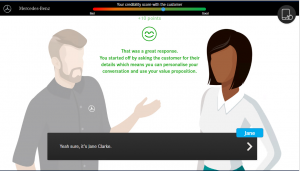
5. Driving Motivation & Engagement by making the Scenarios Challenging
Assessments can be leveraged to drive learner motivation and engagement. By incorporating gamification elements, such as leader boards, badges, or rewards tied to assessments, learners are motivated to perform well and achieve higher scores. Gamified assessments create a sense of competition, foster a positive learning environment, and make the eLearning experience more enjoyable, thus boosting learner engagement and retention. You also need to consider the challenge of the assessment. Providing complexity to the scenario or situation helps to focus on what is needed to be practised.
Working with Lloyds to rethink their approach to training their contact centre staff, we wanted to give the learners a real taste of the work they would be doing with customers. Creating a simulated environment for learners to practice real to life situations- including real names to make it more personal, providing cues and adding “voices” by using quotation marks, made it more real and allowed them to model how the questions and conversations should be said. Making it less obvious which answer is correct also showed the learners that they need to understand the content to know how to answer the question.
Cathy Moore shares some great insight into how to write challenging scenario questions here.
We also built into their custom LMS leader boards and badges that allowed the learners to see where they were on their learning journey to keep motivation high and also allow the trainers to have a snapshot view of anyone needing extra support.
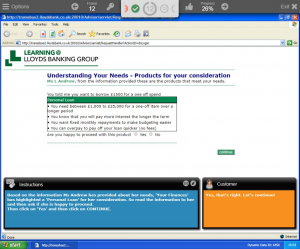
Conclusion
In conclusion, assessments are a critical component of eLearning that go beyond simply testing knowledge at the end of a course. They are powerful tools that measure learning outcomes, promote active engagement and a Learning by Doing approach, reinforce learning, and provide valuable feedback.
By strategically implementing assessments throughout the eLearning journey, we not only assess learners’ progress but also inform instructional design decisions, driving continuous improvement.
Embracing the multifaceted role of assessments empowers us to create impactful eLearning experiences that maximise learner engagement, retention, and application of knowledge.
Remember, assessments are not merely a final destination; they are the stepping stones towards successful eLearning outcomes.
Here at Day One, we’re specialists in creating highly effective scenario based training, and are working on a range of exciting projects.
Contact us to discuss how we could help to make your training more efficient and effective.
Related sections of our site:
Details of the sectors we have worked in can be found here.
An overview of our Case Studies can be found here.
We have worked with some amazing clients utilising scenario based assessments, you can see more about the work we did via their case studies –

